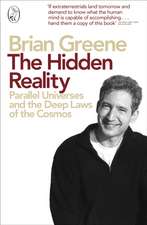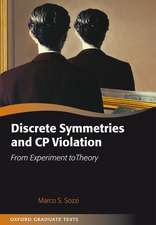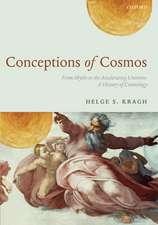Physics of Life: The Physicist's Road to Biology
Autor Clas Blombergen Limba Engleză Hardback – 30 sep 2007
- Describes how physics is needed for understanding basic principles of biology- Discusses the delicate balance between order and disorder in living systems - Explores how physics play a role high biological functions, such as learning and thinking
Preț: 602.31 lei
Preț vechi: 782.22 lei
-23% Nou
Puncte Express: 903
Preț estimativ în valută:
115.25€ • 120.33$ • 95.39£
115.25€ • 120.33$ • 95.39£
Carte tipărită la comandă
Livrare economică 04-18 aprilie
Preluare comenzi: 021 569.72.76
Specificații
ISBN-13: 9780444527981
ISBN-10: 0444527982
Pagini: 440
Dimensiuni: 165 x 240 x 23 mm
Greutate: 0.93 kg
Ediția:New.
Editura: ELSEVIER SCIENCE
ISBN-10: 0444527982
Pagini: 440
Dimensiuni: 165 x 240 x 23 mm
Greutate: 0.93 kg
Ediția:New.
Editura: ELSEVIER SCIENCE
Public țintă
Students, researchers and professionals in physics and biologyCuprins
<I. General Introduction
1. Introduction
2. Physics of Life. Physics of Two Levels
II. Basic Physics Concepts
3. Concepts and Numerical Reference
4. Basis of Classical (Newtonian) Dynamics
5. Electricity - The Core of Reductionism Basis
6. Quantum mechanics
7. Basic Thermodynamics; Introduction
8. Statistical Thermodynamics
III. The General Trends and the Objects
9. Some Trends in 20th Century Physics
10. From Simple to Complex Systems
11. Theoretical Physics Models; Important Analogies
12. The Biological Objects
13. What is Life?
IV. Going Further with Thermodynamics
14. Thermodynamic Formalism and Examples
15. Examples of Entropy and Order/Disorder
16. Statistical Thermodynamics Models
V. Stochastic Dynamics
17. Basic Probability Concepts
18. Stochastic Processes
19. Random Walk*
20. Stochastic Step Processes; Master Equations*
21. Brownian Motion, First Description*
22. Diffusion and Continuous Stochastic Processes*
23. Brownian Motion, Continuation*
VI. Basic Macromolecular Applications
24. Protein Folding and Structure Dynamics
25. Basis of Enzyme Kinetics
VII Non-linearity
26. General Introduction to Non-linearity
27. Oscillations and Space Variations*
28. Deterministic Chaos
29. Noise and Nonlinear Phenomena
VIII. Applications
30. Recognition and Selection in Biological Processes
31. Brownian Ratchet, Unidirectional Processes
32. Neural System
33. Origin of Life
IX Going Further
34. Physics Aspects on Evolution
35. Determinism and Randomness
36. Higher Functions of Life
37. About the Direction of Time
38. We are in the Best of Worlds; The Anthropic Principle
1. Introduction
2. Physics of Life. Physics of Two Levels
II. Basic Physics Concepts
3. Concepts and Numerical Reference
4. Basis of Classical (Newtonian) Dynamics
5. Electricity - The Core of Reductionism Basis
6. Quantum mechanics
7. Basic Thermodynamics; Introduction
8. Statistical Thermodynamics
III. The General Trends and the Objects
9. Some Trends in 20th Century Physics
10. From Simple to Complex Systems
11. Theoretical Physics Models; Important Analogies
12. The Biological Objects
13. What is Life?
IV. Going Further with Thermodynamics
14. Thermodynamic Formalism and Examples
15. Examples of Entropy and Order/Disorder
16. Statistical Thermodynamics Models
V. Stochastic Dynamics
17. Basic Probability Concepts
18. Stochastic Processes
19. Random Walk*
20. Stochastic Step Processes; Master Equations*
21. Brownian Motion, First Description*
22. Diffusion and Continuous Stochastic Processes*
23. Brownian Motion, Continuation*
VI. Basic Macromolecular Applications
24. Protein Folding and Structure Dynamics
25. Basis of Enzyme Kinetics
VII Non-linearity
26. General Introduction to Non-linearity
27. Oscillations and Space Variations*
28. Deterministic Chaos
29. Noise and Nonlinear Phenomena
VIII. Applications
30. Recognition and Selection in Biological Processes
31. Brownian Ratchet, Unidirectional Processes
32. Neural System
33. Origin of Life
IX Going Further
34. Physics Aspects on Evolution
35. Determinism and Randomness
36. Higher Functions of Life
37. About the Direction of Time
38. We are in the Best of Worlds; The Anthropic Principle












